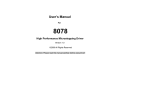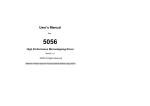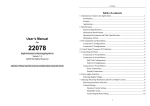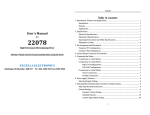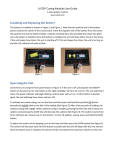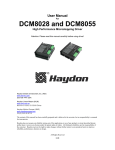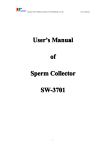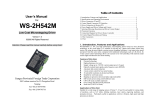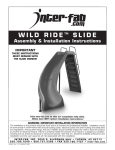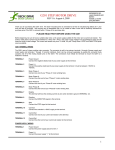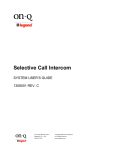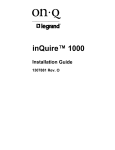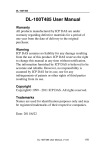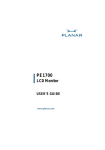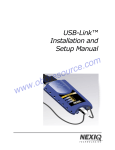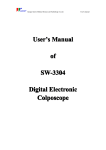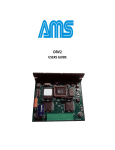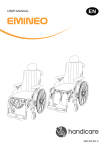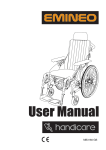Download MD2278
Transcript
The content in this manual has been carefully prepared and is believed to be accurate, but no responsibility is assumed for inaccuracies. User’s Manual For MD2278 High Performance Microstepping Driver Version 1.0 ©2000 All Rights Reserved Attention: Please read this manual carefully before using driver! FULLING reserves the right to make changes without further notice to any products herein to improve reliability, function or design. FULLING does not assume any liability arising out of the application or use of any product or circuit described herein; neither does it convey any license under its patent rights of others. FULLING’s general policy does not recommend the use of its products in life support or aircraft applications wherein a failure or malfunction of the product may directly threaten life or injury. According to FULLING’s terms and conditions of sales, the user of FULLING’s products in life support or aircraft applications assumes all risks of such use and indemnifies FULLING against all damages. MD2278 High Performance Microstepping Driver V1.0 Table of Contents MD2278 High Performance Microstepping Driver V1.0 Applications of this driver Applicable for automated machinery and equipment, for instance, air-driven inscription machines, labeling machines, cutting machines, laser engraving, plotter, medical instruments, and pick-place devices. 1. Introduction, Features and Applications ···································································2 2. Specifications and Operating Environment ······························································3 3. Driver Connectors P1 and P2 ···················································································4 4. Control Signal Connector (P1) Interface ····································································5 5. Driver Connection to Motors (P2) ············································································6 6. Power Supply and Driver Voltage and Current ···························································9 7. Selecting Microstep Resolution and Driver Current Output········································11 8. Protection Functions ··································································································12 9. Connection Diagram for Driver, Motor, Controller ····················································13 10. Control Signal Waveform and Timing ······································································13 11. Wire Connection ······································································································14 Appendix: Limited Warranty ·························································································15 2. Specifications and Operating Environment Electric Specifications (Tj = 25℃) MD2278 Parameters Min. Typical Max. Unit Output Current 0.42 (RMS0.3A) - 7.8 Amps Supply voltage (DC) 80 180 250 VAC Logic signal current 7 10 16 mA Pulse input frequency 0 - 400 Isolation resistance 500 Khz MΩ Operating Environment and Parameters 1. Introduction, Features and Applications MD2278 are high performance microstepping drivers incorporating the most advanced technology in the world today. They are suitable for driving any 2-phase and 4-phase hybrid step motors(current 7.8A/3.9A). By using advanced bipolar constant-current chopping technique, they can produce more motor torque at high speed than other drivers. The microstep capability allows stepping motors run at higher smoothness, less vibration and lower noise. The 3-state current control feature leads to lower motor heating. Cooling Natural cooling or forced convection Environment Space Avoid dust, oil frost and corrosive gas Temperature 0°- 50℃ Humidity 40 - 90%RH Vibration 5.9m/s Max Storge Temp. 2 -20℃ - 125℃ Weight Approx. 1.16 kg (41 oz) Mechanical Dimensions (unit:mm, 1 inch = 25.4 mm) Features of this driver High quality, low price Low heating for motor & driver Supply voltage AC80-250V TTL compatible inputs Automatic idle-current reduction Output current up to 7.8A peak (RMS 5.57A) Input frequency up to 400KHz Opto-isolated inputs Microstep resolution pulse per rotation selectable vary from 400, 500, 600, 800, 1000, 1200, 1600, 2000, 2400, 3200, 4000, 5000, 6000, 6400, 8000 and 10000 Suitable for any 2-phase stepping motor with 4,6,8 leads Front View DIP switch current setting Side View Figure 1: Mechanical dimensions CW/CCW mode available (optional) *Recommended to use side mounting for better heat dissipation 2 3 MD2278 High Performance Microstepping Driver V1.0 MD2278 High Performance Microstepping Driver V1.0 Power connector P2 pins Extra Heat Sink Driver’s reliable working temperature should be <65℃, motor temperature <80℃; Signal Functions AC It is recommended automatic half-current mode, i.e. current automatically reduced by AC AC input, varies from 80V to 220V, recommended to use 180V. 60% when motor stops, so as to decrease driver and motor’s heating; Phase A Motor coil A (leads A+ and A-) Please mount the driver vertically to maximize heat sink area. 3. Driver Connectors, P1 and P2 Phase B Motor coil B (leads B+ and B-) PE Connect ground terminal 4. Control Signal Connector (P1) Interface The driver has two connectors, P1 for control signals, and P2 for power and motor connections. The following is a brief description of the two connectors of the driver. More detailed descriptions of the pins and related issues are presented in section 4, 5, 6, 9. Control Signal Connector P1-pins Signal Functions PUL﹢(+5V) Pulse signal: in single pulse(pulse/direction) mode, this input represents pulse signal, effective for each upward – rising edge; in double pulse PUL- (PUL) mode (pulse/pulse) this input represents clockwise(CW)pulse. For reliable response, pulse width should be longer than 1.5µs. DIR+ (+5V) Direction signal: in single-pulse mode, this signal has low/high voltage levels, representing two directions of motor rotation; in double-pulse mode (set by inside jumper JMP1), this signal is counter-clock (CCW) DIR- (DIR) pulse, effective on each rising edge. For reliable motion response, direction signal should be sent to driver 2µs before the first pulse in the reverse motion direction. ENA+ (+5V) Enable signal: this signal is used for enable/disable, high level for enabling driver and low level for disabling driver. Usually left ENA- (ENA) unconnected(enabled). READY+ Output alarm signal positive: READY is a photocouper output from open-collector circuit, effectively output when driver operate normally, maximum permitted input voltage 30VDC; maximum output current 20mA, generally can be serial connected to PLC input terminal. READYOutput alarm signal negative. This driver uses differential inputs to increase noise immunity and interface flexibility. Single-ended control signals from the indexer/controller can also be accepted by this interface. The input circuit has built-in high-speed opto -coupler, and can accept signals in the format of line driver, open-collector, or PNP output. Line driver (differential) signals are suggested for reliability. In the following figures, connections to open-collector and PNP signals are illustrated. Remark 1: SW5 ON means PUL/DIR mode , OFF means CW/CCW (pulse/pulse) mode. Remark 2: Please note motion direction is also related to motor-driver wiring match. Exchanging the connection of two wires for a coil to the driver will reverse motion direction. (for example, reconnecting motor A+ to driver A- and motor A- to driver A+ will invert motion direction). 4 5 MD2278 High Performance Microstepping Driver V1.0 MD2278 High Performance Microstepping Driver V1.0 5. Driver Connection to Step Motors MD2278 driver can drive any 4, 6, 8 lead hybrid step motors. The following diagrams illustrate connection to various kinds of motor leads: Parallel Connection An 8 lead motor in a parallel configuration offers a more stable, but lower torque at lower speeds. But because of the lower inductance, there will be higher torque at higher speeds. Multiply the per phase (or unipolar) current rating by 1.96, or the bipolar current rating by 1.4, to determine the peak output current. Figure 5: 8 Lead Motor Parallel Connections Figure 3: Driver Connection to Step Motor 5.2 Note that when two coils are parallelly connected, coil inductance is reduced by half and motor speed can be significantly increased. Serial connection will lead to increased inductance and thus the motor can be run well only at lower speeds. 5.1 Connecting to 8-Lead Motors 8 lead motors offer a high degree of flexibility to the system designer in that they may be connected in series or parallel, thus satisfying a wide range of applications. Series Connection A series motor configuration would typically be used in applications where a higher torque at lower speeds is required. Because this configuration has the most inductance, the performance will start to degrade at higher speeds. Use the per phase (or unipolar) current rating as the peak output current, or multiply the bipolar current rating by 1.4 to determine the peak output current. Connection to 6-Lead Motors Like 8 lead stepping motors, 6 lead motors have two configurations available for high speed or high torque operation. The higher speed configuration, or balf coil, is so described because it uses one half of the motor’s inductor windings. The higher torque configuration, or full coil, use the full windings of the phases. Half Coil Configuration As previously stated, the half coil configuration uses 50% of the motor phase windings. This gives lower inductance, hence, lower torque output. Like the parallel connection of 8 lead motor, the torque output will be more stable at higher speeds. This confi8guration is also referred to as bal copper. In setting the driver output current multiply the specified per phase (or unipolar) current rating by 1.4 to determine the peak output current. Figure 4: 8 Lead Motor Series Connections 6 7 MD2278 High Performance Microstepping Driver V1.0 MD2278 High Performance Microstepping Driver V1.0 Figure 8: 4 Lead Motor Connections Figure 6: 6 Lead Half Coil (Higher Speed) Motor Connections Full Coil Confuguration The full coil configuration on a six lead motor should be used in applications where higher torque at lower speeds is desired. This configuration is also referred to as full copper. Use the per phase (or unipolar) current rating as the peak output current. 6. Power supply Selection, Driver Voltage and Current Selection 6.1 Power Supply Selection It is important to choose appropriate power supply to make the driver operate properly and deliver optimal performance. Maximum Voltage Input: The power MOSFETS inside the driver can actually operate within +80-+220VAC, including power input fluctuation and back EMF voltage generated by motor coils during motor shaft deceleration. Higher voltage will damage the driver. Therefore, it is suggested to use power supplies with theoretical output voltage of no more than +220V, leaving room for power line fluatuation and Back EMF. Figure 7: 6 Lead Full Coil (Higher Torque) Motor 5.3 Connection to 4-Lead Motors 4 lead motors are the least flexible but easiest to wire. Speed and torque will depend on winding inductance. In setting the driver output current, multiply the specified phase current by 1.4 to determine the peak output current. 8 Regulated or Unregulated power supply: Both regulated and unregulated power supplies can be used to supply DC power to the driver. However, unregulated power supplies are preferred due to their ability to withstand current surge. If regulated power supply (such as most switching supplies.) is indeed used, it is important to have large current output rating to avoid problems like current clamp, for example using 4A supply for 3A motor-driver operation. On the other hand, if unregulated supply is used, one may use a power supply of lower current rating than that of motor (typically 50%~ 70% of motor current). The reason is that the driver draws current from the power supply capacitor of the unregulated supply only during the ON duration of the PWM cycle, but not during OFF duration. Therefore, the average current withdrawn from power supply is considerably less than motor current. For example, two 3A motors can be well supplied by one power supply of 4A rating. 9 MD2278 High Performance Microstepping Driver V1.0 Multiple drivers: It is recommended to have multiple drivers to share one power supply to reduce cost, provided that the supply has enough capacity. To avoid cross interference, DO NOT dazy-chain the power supply input pin of the drivers. (instead, please connect them to power supply separately.) Higher supply voltage will allow higher motor speed to be achieved, at the price of more noise and heating. If the motion speed requirement is low, it’s better to use lower supply voltage to improve noise, heating and reliability. NEVER connect power and ground in the wrong direction, as it will damage the driver. 6.2 MD2278 High Performance Microstepping Driver V1.0 7. Selecting Microstep Resolution and Driver Current Output This driver uses a 9-bit DIP switch to set microstep resolution, motor operating current and pulse mode selection, as shown below: Driver Voltage and Current Selection This driver can match small and medium size step motors (NEMA 43 and 51) made by FULLING or other motor manufactures from around the world. To achieve good driving results, it is important to select supply voltage and output current properly. Generally, supply voltage determines the high speed performance of the motor, while output current determines the output torque of the driven motor (particularly at lower speed). 7.1 Microstep Resolution Selection Microstep resolution is set by SW1-SW4 of the DIP switch as shown in the following table: ● Selecting Supply Voltage: Higher supply voltage can increase motor torque at higher speeds, thus helpful for avoiding losing steps. However, higher voltage may cause more motor vibration at lower speed, and it may also cause over-voltage protection and even driver damage. Therefore, it is suggested to choose only sufficiently high supply voltage for intended applications. ● Setting Proper Output Current a. For a given motor, higher driver current will make the motor to output more torque, but at the same time causes more heating in the motor and driver. Therefore, output current is generally set to be such that the motor will not overheat for long time operation. b. c. Since parallel and serial connections of motor coils will significantly change resulting inductance and resistance, it is therefore important to set driver output current depending on motor phase current, motor leads and connection methods. Phase current rating supplied by motor manufacturer is important to selecting driver current, but the selection also depends on leads and connection. ustep/rev.(for 1.8°motor) SW1 SW2 SW3 400 ON ON ON SW4 ON 500 OFF ON ON ON 600 ON OFF ON ON 800 OFF OFF ON ON 1000 ON ON OFF ON 1200 OFF ON OFF ON 1600 ON OFF OFF ON 2000 OFF OFF OFF ON 2400 ON ON ON OFF 3200 OFF ON ON OFF 4000 ON OFF ON OFF 5000 OFF OFF ON OFF 6000 ON ON OFF OFF 6400 OFF ON OFF OFF 8000 ON OFF OFF OFF 10000 OFF OFF OFF OFF 7.2 Current Setting The SW6-SW9 of the DIP switch are used to set the current during motion (dynamic current ). Select a setting closest to your motor’s required current. 10 11 MD2278 High Performance Microstepping Driver V1.0 c. Over-current Protection Protection will activated in case of short current which may otherwise damage the driver. DIP Setting for current during motion: MD2278 MD2278 High Performance Microstepping Driver V1.0 DIP switch setting Peak current (A) RMS (A) SW6 SW7 SW8 SW9 0.45 0.32 OFF OFF OFF OFF 0.63 0.45 OFF OFF OFF ON 1.41 1.00 OFF OFF ON OFF 1.88 1.34 OFF OFF ON ON 2.33 1.66 OFF ON OFF OFF 2.85 2.04 OFF ON OFF ON 3.23 2.31 OFF ON ON OFF 3.75 2.68 OFF ON ON ON 4.26 3.04 ON OFF OFF OFF 4.65 3.32 ON OFF OFF ON 5.18 3.70 ON OFF ON OFF 5.55 3.96 ON OFF ON ON 6.15 4.39 ON ON OFF OFF 6.60 4.71 ON ON OFF ON 7.20 5.14 ON ON ON OFF 7.80 5.57 ON ON ON ON Attention: since there is no protection against power leads (﹢, ﹣) reversal, it is critical to make sure that power supply leads correctly connected to driver. Otherwise, the driver will be damaged instantly. 9. Connection Diagram for Driver, Motor, Controller A complete stepping system should include stepping motor, stepping driver, power supply and controller (pulse generator). A typical connection is shown below: Remarks: Due to motor inductance the actual current in the coil may be smaller than the dynamic current settings, particularly at higher speeds. Static current The current automatically reduced to 60% of dynamic current setting 0.2 second after the last pulse, this will, theoretically, reduce motor heating to 36% (due to I*I) of the original value. DIP setting for pulse mode: SW5 is used for this purpose. ON means CW/CCW mode, OFF means PUL/DIR mode. 8. Protection Functions Over-voltage, short-voltage, over-current, over-heating and short-circuit protection Figure 9: Driver connection in a stepping system To improve reliability, the driver incorporates a number of built-in protections features. a. Over-voltage protection and short-voltage protection When power supply voltage exceeds +250VAC, protection will be activated and power indicator LED will turn red. When power supply voltage is lower than +80VAC, the driver will not works properly. 10. Control signal Waveform and Timing In order to avoid some fault operation and deviation, PUL, DIR and ENA must accord with some parameters, as following diagram: b. Coil-ground Short Circuit Protection Protection will be activated in case of short circuit between motor coil and ground. 12 13 MD2278 High Performance Microstepping Driver V1.0 MD2278 High Performance Microstepping Driver V1.0 TWELVE MONTH LIMITED WARRANTY FULLING MOTOR Co., Ltd. warrants its products against defects in materials and workmanship for a period of 12 months from receipt by the end-user. During the warranty period, FULLING will either, at its option, repair or replace products which prove to be defective. EXCLUSIONS The above warranty shall not apply to defects resulting from: improper or inadequate handling by customer; improper or inadequate customer wiring; unauthorized modification or misuse; or operation outside of the electrical and/or environmental specifications for the product. OBTAINING WARRANTY SERVICE Remark: (1) t1: ENA must be ahead of DIR by at least 5us, logic HIGH as valid. Generally To obtain warranty service, a returned material authorization number (RMA) must be obtained before returning product for service. from customer service at e-mail: Customer shall prepay shipping charges for products returned to FULLING for warranty service, and FULLING shall pay for return of products to customer. ENA+ and ENA- is NC (not connected). (2) t2: DIR must be ahead of PUL effective falling edge by 5us to ensure correct direction; WARRANTY LIMITATIONS FULLING makes no other warranty, either expressed or implied, with respect to the product. FULLING specifically disclaims the implied warranties of merchantability and fitness for a particular purpose. Some jurisdictions do not allow limitations on how long and implied warranty lasts, so the above limitation or exclusion may not apply to you. However, any implied warranty of merchantability or fitness is limited to the 12-month duration of this written warranty. (3) t3: Pulse width not less than 1.2us; (4) t4: low level width not less than 1.2us. 11. Wire Connection (1) In order to improve driver noise rejection, it is recommended to use twist ed Shipping Failed Product pair shield cable. (2) To prevent noise incurred in pulse/dir signal, Pulse/direction signal wires and motor wires should not be tied up together. It is better to separate them by at least 10 cm, otherwise the motor noise will easily disturb pulse direction signals, motor position error, system instability and other types of failure. If your product should fail during the warranty period, e-mail customer service at to obtain a returned material authorization number before returning product for service. Please include a written description of the problem along with contact name and address. Send failed product to distributor in your area or: Changzhou Fulling motor Co.,Ltd. 66 Zhujiang Road ChangZhou city JiangSu Province China. Also enclose information regarding the circumstances prior to product failure. (3) If a power supply serves several drivers, separate connections drivers is recommended instead of daisy-chaining. (4) It is prohibited to pull and plug connector P2 while driver is powered ON, as there is still high current flowing through coil even when motor is stopped. Pulling and plugging P2 with power on will cause extremely high voltage surge EMF, destroy the dirver. 14 15








